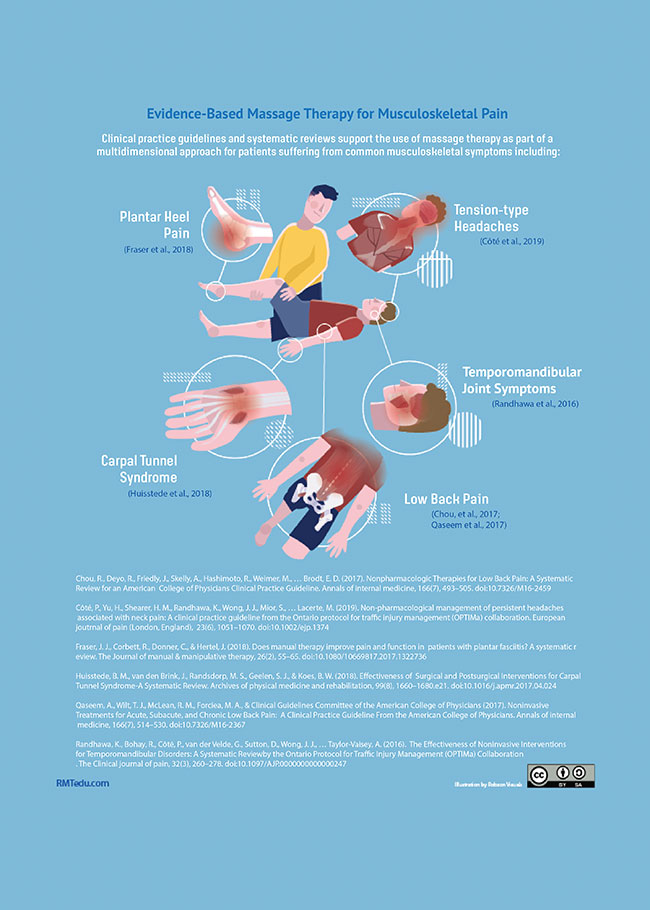
Features
Patient Care
Research
Wellness
Massage therapy for people living with MSK pain [INFOGRAPHIC]
July 27, 2020 By Richard Lebert

Chronic MSK pain is associated with significant social and economic costs. Conventional treatment options such opioid-based analgesics, corticosteroid injections, and surgical interventions are associated with small improvements versus placebo and an increased risk of harm, prompting stakeholders to re-evaluate how treatment is provided for people living with chronic MSK pain.
Musculoskeletal pain is a complex and multifactorial phenomenon and treatment requires an individualized multidisciplinary approach that addresses biopsychosocial influences and empowers people with shared decision-making. Increasingly, evidence-based non-pharmacological treatments options are being integrated with standard care as part of a person-centered approach.
The paradigm shift to an evidence-based multidisciplinary approach presents an opportunity for RMTs to collaborate with other healthcare professionals to improve a patient’s health and treatment outcome. With respect to the multidisciplinary treatment of pain, massage therapy has a desirable safety profile and it is a health care option that has been shown to be effective for many persistent pain syndromes. What is often not appreciated is that a number of clinical practice guidelines and systematic reviews support the use of massage therapy for patients suffering from a whole host of conditions, including but not limited to: back pain, tension-type headaches, TMJ disorder, carpal tunnel syndrome, and plantar heel pain. For example, the endorsement from the American College of Physicians who now recognizes massage therapy as a treatment option for patients with acute and chronic low back pain. The Canadian Guideline for Opioid and Chronic Non-Cancer Pain now recommends a trial of massage therapy rather than a trial of opioids for a number of conditions including: back and neck pain, osteoarthritis of the knee and headaches.
References
- Busse, J. W. et al.(2017) Guideline for opioid therapy and chronic noncancer pain. Canadian Medical Association journal, 189(18), E659–E666. doi:10.1503/cmaj.170363
- Chou, R. et al.(2017) Nonpharmacologic Therapies for Low Back Pain: A Systematic Review for an American College of Physicians Clinical Practice Guideline. Annals of internal medicine, 166(7), 493–505. doi:10.7326/M16-2459
- Chou, R. et al. (2020) Opioid Treatments for Chronic Pain. Agency for Healthcare Research and Quality (US).DOI:https://doi.org/10.23970/AHRQEPCCER229.
- Côté, P. et al. (2019) Non-pharmacological management of persistent headaches associated with neck pain: A clinical practice guideline from the Ontario protocol for traffic injury management (OPTIMa) collaboration. European journal of pain (London, England), 23(6), 1051–1070. doi:10.1002/ejp.1374
- Fraser, J. J. et al. (2018). Does manual therapy improve pain and function in patients with plantar fasciitis? A systematic review. The Journal of manual & manipulative therapy, 26(2), 55–65. doi:10.1080/10669817.2017.1322736
- Huisstede, B. M. et al. (2018) Effectiveness of Surgical and Postsurgical Interventions for Carpal Tunnel Syndrome-A Systematic Review. Archives of physical medicine and rehabilitation, 99(8), 1660–1680.e21. doi:10.1016/j.apmr.2017.04.024
- Lin, I. et al.(2020) What does best practice care for musculoskeletal pain look like? Eleven consistent recommendations from high-quality clinical practice guidelines: systematic review. British journal of sports medicine, 54(2), 79–86. doi:10.1136/bjsports-2018-099878
- Qaseem, A. et al. (2017) Noninvasive Treatments for Acute, Subacute, and Chronic Low Back Pain: A Clinical Practice Guideline From the American College of Physicians. Annals of internal medicine, 166(7), 514–530. doi:10.7326/M16-2367
- Randhawa, K., Bohay, R., Côté, P., van der Velde, G., Sutton, D., Wong, J. J., … Taylor-Vaisey, A. (2016). The Effectiveness of Noninvasive Interventions for Temporomandibular Disorders: A Systematic Review by the Ontario Protocol for Traffic Injury Management (OPTIMa) Collaboration. The Clinical journal of pain, 32(3), 260–278. doi:10.1097/AJP.0000000000000247
- Skelly, A.C., et al. (2020) Noninvasive Nonpharmacological Treatment for Chronic Pain: A Systematic Review Update. Rockville (MD): Agency for Healthcare Research and Quality (US). DOI: https://doi.org/10.23970/ AHRQEPCCER227
Richard Lebert works in Petrolia Ontario and is associate faculty at Lambton College. Richard runs an online resource (RMTedu.com) exploring long-term solutions that promote growth and development of the profession. When he is not in the clinic his favorite activities are hiking, camping and kayaking with family and friends.
Print this page